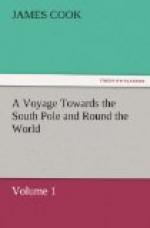The 22d we steered E.S.E. with a fresh gale at north, blowing in squalls, one of which took hold of the mizen top-sail, tore it all to rags, and rendered it forever after useless. At six o’clock in the morning, the wind veering towards the west, our course was east northerly. At this time we were in the latitude of 67 deg. 31’, the highest we had yet been in, longitude 142 deg. 54’ W.
We continued our course to the E. by N. till noon, the 23d, when being in the latitude of 67 deg. 12’, longitude 138 deg. 0’, we steered S.E.; having then twenty-three ice islands in sight, from off the deck, and twice that number from the mast-head; and yet we could not see above two or three miles round us. At four o’clock in the afternoon, in the latitude of 67 deg. 20’, longitude 137 deg. 12’, we fell in with such a quantity of field, or loose ice, as covered the sea in the whole extent from south to east, and was so thick and close as wholly to obstruct our passage. At this time, the wind being pretty moderate, and the sea smooth, we brought-to, at the outer edge of the ice, hoisted out two boats, and sent them to take some up. In the mean time, we laid hold of several large pieces along-side, and got them on board with our tackle. The taking up ice proved such cold work, that it was eight o’clock by the time the boats had made two trips, when we hoisted them in, and made sail to the west, under double-reefed top-sails and courses, with a strong gale at north, attended with snow and sleet, which froze to the rigging as it fell, making the ropes like wires, and the sails like boards or plates of metal. The sheaves also were frozen so fast in the blocks, that it required our utmost efforts to get a top-sail down and up; the cold so intense as hardly to be endured; the whole sea, in a manner, covered with ice; a hard gale, and a thick fog.
Under all these unfavourable circumstances, it was natural for me to think of returning more to the north; seeing no probability of finding any land here, nor a possibility of getting farther south. And to have proceeded to the east in this latitude, must have been wrong, not only on account of the ice, but because we must have left a vast space of sea to the north unexplored, a space of 24 deg. of latitude; in which a large tract of land might have lain. Whether such a supposition was well-grounded, could only be determined by visiting those parts.
While we were taking up ice, we got two of the antarctic peterels so often mentioned, by which our conjectures were confirmed of their being of the peterel tribe. They are about the size of a large pigeon; the feathers of the head, back, and part of the upper side of the wings, are of a light-brown; the belly, and under side of the wings white, the tail feathers are also white, but tipped with brown; at the same time, we got another new peterel, smaller than the former, and all of a dark-grey plumage. We remarked that these birds were fuller of feathers than any we had




